April 2018
IV. the May challenge

Hey everybody,
You’ve probably heard that old saw: “The definition of insanity is doing the same thing over and over again and expecting different results.”
We like to think that anybody who cultivates a practice—whether it’s weightlifting or yoga or painting—would disagree. There’s value in trying something over and over again. You keep trying and eventually you make it happen: you lift the barbell up off the ground, you stand on one leg for longer than ever before, you do the thing you’ve been trying to do and, finally, all the big and little muscles involved answer to the roll call that morning, “Oh yeah, we’ve been meaning to do this.”
Of course, there are a few imperatives here: You must keep a goal in mind; you must know that you will, eventually, get to that goal; and you must try to make it happen. Maybe you want to lift a barbell loaded with some weights above your head. Maybe you just want to lift up a barbell, period. Maybe you want to get strong enough so that you reach a graceful stride in your outside-the-gym life.
Here’s another old saw to keep in mind: “Eighty percent of success is showing up.”
The year is still new, and greatness still calls from a distance. So, with that in mind, please keep on reading. We’ve got a promotion to get you through the door at the gym; a trio of basic, solid exercises to keep you coming in; and enthusiasm to spare.
Happy spring,
Nate and Natalie
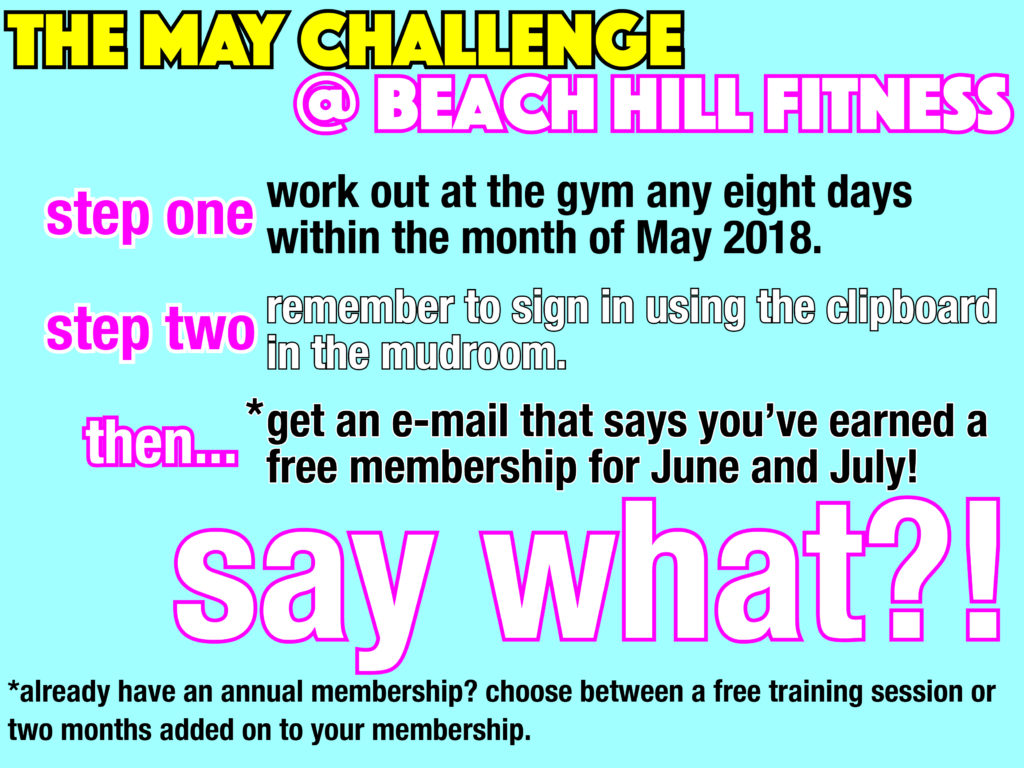
The deadlift


The deadlift is the most basic barbell exercise there is: you practice picking up dead weight off the floor, using good form.
Deadlifts are arguably the best exercise for building strength, since they use almost all the muscles in the body with each rep, focusing mostly on the lower back, abs, and all the muscles in the legs. Whenever I begin to train someone, I likely include the deadlift.
You can practice deadlifts many ways: with a lower weight and more reps, for an added cardiovascular challenge. Or, at a higher weight, or even an increasing range of weights, for more of a strength-based workout. Deadlifts also set you up for more advanced barbell exercises in the future, such as cleans.
To perform a deadlift properly:
1) Step up to a loaded barbell (if you are new to deadlifts, start with a light weight to practice form) with the tops of your shoelaces directly under the bar, heels about 8″ to 12″ apart, toes pointed out from center about 15 degrees and hands gripping the barbell shoulder width apart.
2) Make sure your knees are lower to the floor than your hips and your hips are lower than your shoulders. Take a deep breath and hold it while you press your feet through the floor, lifting the barbell off the ground. This holding of the breath will help lock out your core and help keep your back from rounding.
3) While lifting the barbell, keep the barbell as close to your body as you can (touching your legs or pants as you lift the bar). Remember to keep your chest up and back flat so your lower back is not doing more work than it should. When the barbell rises above your knees you can exhale and finish the rep, coming to a full hip extension.
4) Bring the barbell back down to the floor to touch the ground and do it again.
Rep schemes I would recommend for deadlift are 5 reps x 5 sets, 3 x 5, 10 x 5, or 1 x 7. When doing these rep schemes I usually do some warm up sets to work up to heavier weights. For example, if I want to go heavy, I’ll do a 3 x 5 rep scheme at a heavy weight. But if I want to perform my deadlifts as part of a faster and lighter workout with more reps to build endurance, I might do 10 x 5 at a weight that’s about two-thirds of my 1-rep-max, which is the heaviest weight I can deadlift exactly once.
I usually try to mix up my rep schemes and not do the same mix of reps twice in a row. Also, I only attempt my 1-rep-max deadlift once or twice per year.
Seated shoulder press
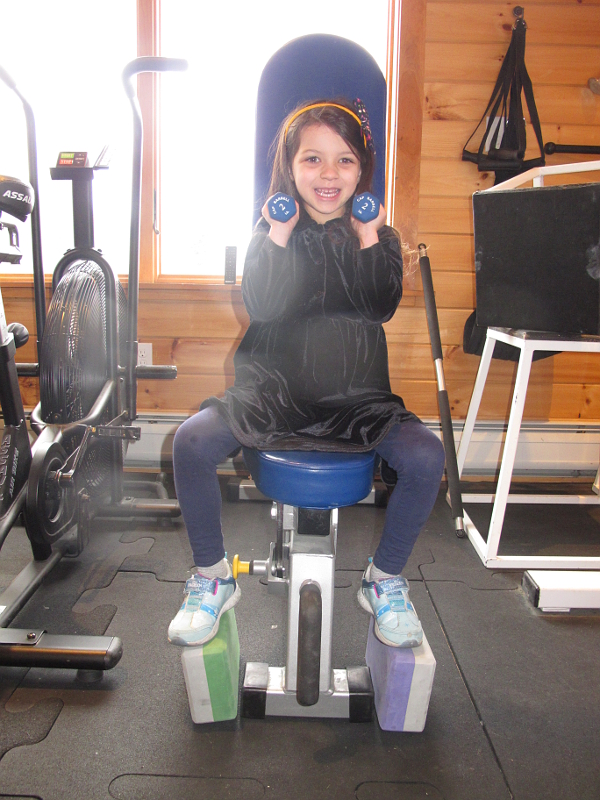
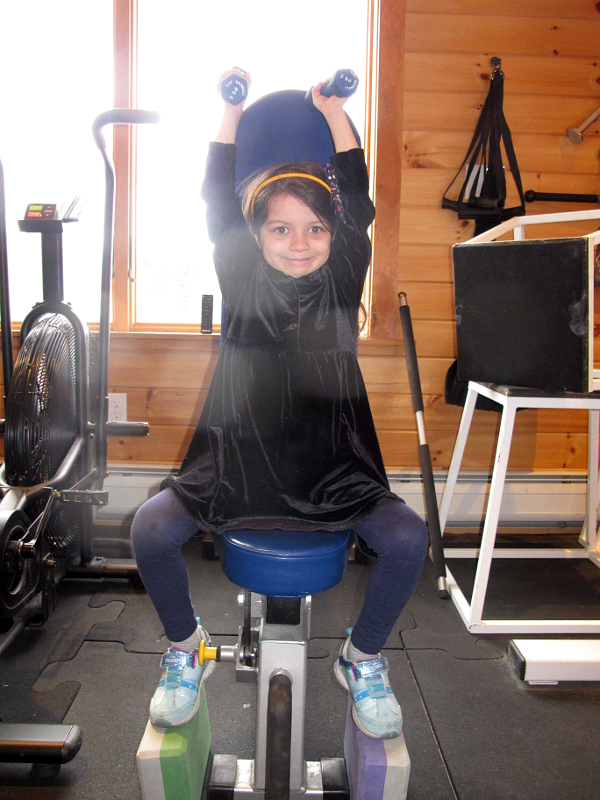
The seated shoulder press is another great basic strength-building exercise. Any time you are doing a shoulder press in the gym you are practicing bringing something over your head from shoulder level. The main muscle groups targeted in this exercise are the shoulders, chest, and triceps. I typically do seated shoulder presses with dumbbells, as using a separate object in each hand helps even out the strength between both sides of your body.
Seated shoulder presses are great for any skill level, and they help lay the foundation to move on to more complicated shoulder-to-overhead exercises in the future, such as push press, push jerk, and split jerk.
This basic shoulder press is also a nice complement to deadlifts because it allows you to mix an upper body pressing exercise with a lower body pulling exercise, giving you a well-rounded workout.
To perform a seated shoulder press properly:
1) Seat yourself fully upright with your back and head firmly against the back of the seat. (Our lovely assistant Luna, pictured above, used a couple yoga blocks to raise the floor to her feet.)
2) Start with the dumbbells at shoulder level with your elbows out in front. Keep elbows pointing forward; don’t let them flare to the sides, or rest against your chest.
3) Use your leg drive to assist in your press by pressing your feet through the floor. You should have tension running through your legs and be able to feel more power going through your spine, resulting in more strength for pressing.
4) Press the dumbbells directly overhead until your arms are fully extended and bring the dumbbells back down to your starting position while maintaining control of the dumbbells at all times.
One of my favorite rep schemes for this exercise is with sets of 10-8-6-4-2, decreasing the reps each round while increasing the weight. The classic 5 reps x 5 sets is also recommended.
Medicine ball power clean
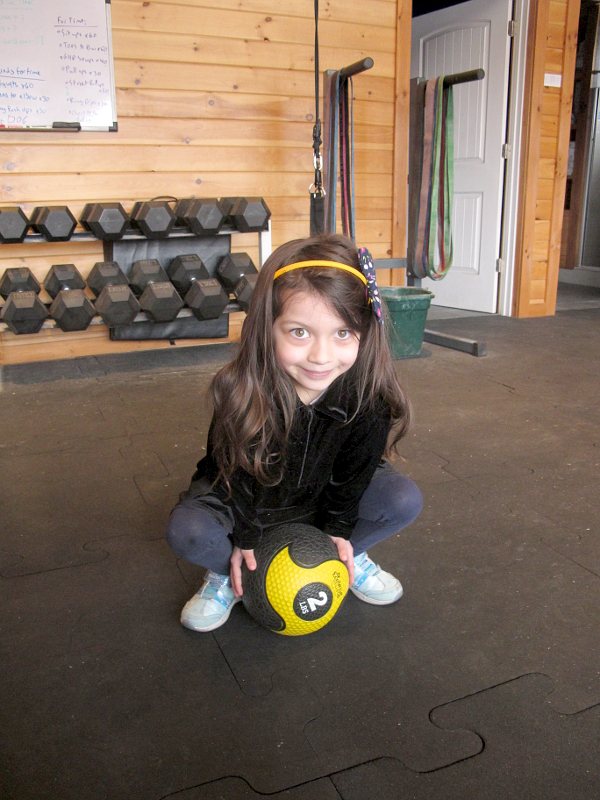
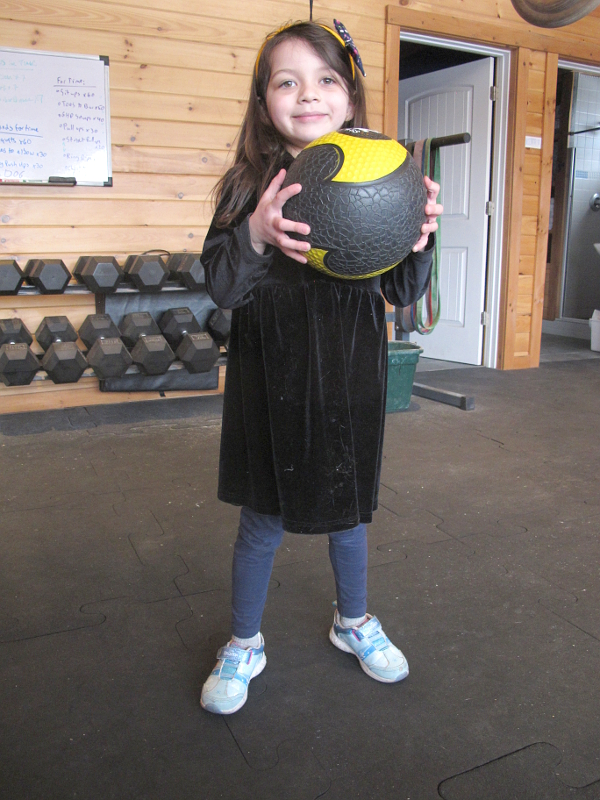
Medicine ball power cleans are an excellent primer if you want to learn barbell cleans. They are also great for just practicing picking something up from the ground and bringing it to your shoulders in one movement. Power cleans target just about all of your muscles and are an explosive exercise to build athletic coordination because of the many moving parts that come together to make a successful rep.
Med ball power cleans are also good for any skill level. This exercise builds a solid base to progress towards dumbbell cleans, kettlebell cleans, and finally barbell cleans.
To perform med ball power cleans:
1) Take a stance similar to deadlift with feet several inches wider and the med ball placed between your feet on the floor. Squat down and grip the ball with hands on either side, body in alignment: First from the floor are your knees then hips then shoulders. If this alignment isn’t happening then something must be corrected.
2) Start to stand up and when the med ball crosses your knees explode higher by slightly jumping off the ground and shrugging your shoulders. Maintain a flat back while keeping your chest up.
3) Drop your elbows under the ball and land in the catching position with the ball situated in front of your upper chest/neck, elbows under the ball. Finish the rep by standing up and fully extending your hips.
4) Bring the ball back down and touch the floor with it and repeat.
Med ball cleans can get your heart rate going pretty quickly and should ideally be done with lower weights and higher reps. I like 3 to 5 sets of between 20 to 50 reps depending on what else you are doing in conjunction with this exercise.
Try this: workout IV
TRY THIS: Workout IV
Three rounds, rest as needed:
- Deadlift x 5
- Seated shoulder press x 10
- Med ball power clean x 20
This is a great beginner workout that covers all areas of training. Weights should be moderate and safe to use while maintaining proper form throughout each exercise. This workout should condition your legs, core, arms, shoulders and heart. These are the same exercises I pose to most people I train in their first training session.
For a beginner scale I would recommend:
Deadlift 55-75#, seated shoulder press 12-17.5#, med ball power clean 10#-14#
Intermediate scale:
Deadlift 125-175#, seated shoulder press 20-30#, med ball power clean 20-30#.
Advanced scale:
Deadlift 275-375#, seated shoulder press 35-55#, med ball power clean 40-80#
Missed our previous newsletters?
Click HERE to read them in full.
What’s new?

WHAT’S NEW: Dumbbells for those in-between reps
Sometimes, the typical five-pound jump from one set of dumbbells to another is just a bit too much, like when you’ve mastered the 15-pound dummbell seated shoulder press, but 20 pounds in each hand is just too big of a leap, for now.
Solution: Beach Hill Fitness now has one set each of 17.5-pound dumbbells and 22.5-pound dumbbells, for when you want to work your way up safely.

See you out there!
@ Beach Hill Fitness
Train with Nate: E-mail [email protected] or call 525-6226
to arrange your appointment.
Yoga: Most Wednesdays at 10 a.m., with Tina Ghantous.
Got a question? Want to know how a machine works? Want to add a class?
E-mail Nate at [email protected]
Open seven days a week. For hours, more information, and to set up personal training with Nate, call 525-6226 or visit the website.
